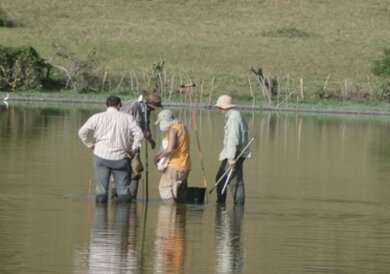The ecological footprint of European colonization at the doorway to the Americas

Historical figures such as Columbus have returned to the centre of public debate. Much remains to be discovered about his legacy and current impact on our society. A new study shows the ecological footprint that the arrival of Europeans left in the Caribbean islands.
Ecological changes
A research group led by Prof. Corinne L. Hofman and Prof. Henry Hooghiemstra has analysed sediment deposits from three locations in the north of the island of Hispaniola (currently the Dominican Republic and Haiti) around the first transport route built by Europeans in America, the 'Columbus Route'.
The team, part of the ERC-synergy NEXUS 1492 project, links the explorer's arrival in the Caribbean to significant ecological changes on this island, representative of how contact between the 'New' and 'Old' World radically altered the landscapes of these first territories colonised in the Americas. The ecological footprint of Christopher Columbus' arrival resulted in a first phase of forest expansion. However, this did not last more than a century and a half and was followed by the drastic degradation of the natural landscape linked to the development of the colonial economy.
Lagoon sediments
The article, led by early career researcher Alvaro Castilla-Beltrán, published in the journal Quaternary Science Reviews, is based on the study of lagoon sediments as archives of natural history, in which microscopic fossils such as pollen grains document how societies altered the landscapes of the past. The island of Hispaniola was the gateway to the new world where the first permanent settlement in the Americas was founded (La Isabela, AD 1493) and where initial cultural and biological collisions occurred because of the encounter of civilizations on both sides of the Atlantic. Columbus already found an island well populated by so-called Taíno cultures, which had commercial ties of that expanded throughout the Caribbean archipelago.
From forest expansion to massive logging
This study also reveals that indigenous peoples had altered the ecosystems before Columbus' arrival through slash-and-burn agriculture. The depopulation of the island caused by epidemics and the forced displacement of indigenous people to mining areas led to episodes of expansion of tropical forests, forests that had been transformed in their composition. However, this process of forest expansion was reversed by massive logging for the establishment of plantations of crops such as tobacco and bananas, which has led to the worrying state of ecological degradation in which this island finds itself today. The study has the added importance of providing a historical overview of the island's landscape that can serve as a guide for restoring these ecosystems.
More information: Alvaro Castilla-Beltrán et al. Ecological responses to land use change in the face of European colonization of Haytí island, Quaternary Science Reviews (2020). DOI: 10.1016/j.quascirev.2020.106407
Journal information: Quaternary Science Reviews
Provided by Leiden University





















